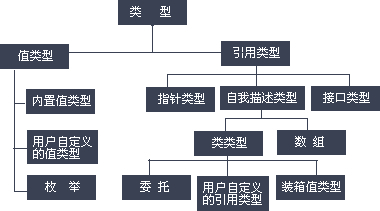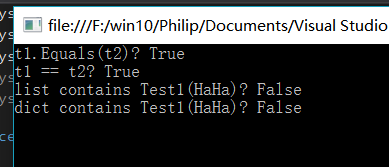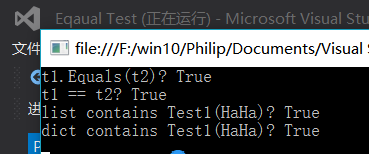1. C#的值类型和引用类型
C#的对象里面有两种类型,一个是引用类型,一个是值类型,值类型和引用类型的具体分类可以看下面的分类。

在C#中,不管是引用类型还是值类型,他们都隐式继承Object类(这里应该这样仔细理解,引用类型是直接地继承Object类,但是值类型是继承的是Object类的子类ValueType。
需要注意的是,C#的对象内存管理方式和C++或者Java都是有非常的不同的,简单来说,C#的内存组织方式是通过栈堆和托管堆的方式组织的。也就是下面这个图展示的那样:

2. Object.Equals方法:
Equal方法,顾名思义,就是一个辨别两个对象是否是一个对象的方法。
在C#中,对于引用类型,其实就是比较两个地址是否是相等的(也就是Object.ReferenceEquals是一样的)。
MSDN中对于怎么写引用类型的Eqaul方法给出了下面的建议:
- Consider overriding Equals if the semantics of the type are based on the fact that the type represents some value(s).
(当你要重载引用形式的equal的时候,你要比较的两个值得语义必须是引用类型)
- Most reference types must not overload the equality operator, even if they override Equals. However, if you are implementing a reference type that is intended to have value semantics, such as a complex number type, you must override the equality operator.
(当你重载了一个引用类型的equal方法的时候,一定不要重载相等运算符==;当你重载的是值类型的equal方法时候,必须重载相等运算符。)
- You should not override Equals on a mutable reference type. This is because overriding Equals requires that you also override the GetHashCode method, as discussed in the previous section. This means that the hash code of an instance of a mutable reference type can change during its lifetime, which can cause the object to be lost in a hash table.
(※不能把Equal方法重载到一个地址可变的量上(因为重载了equal函数我们必须重载GetHashCode方法),一个实例可变引用的散列值会随着他的生存期会一直改变,这会导致我们无法在散列表中找到这个对象。)
关于值类型的Equal方法,MSDN给出了下面的建议:
- If you are defining a value type that includes one or more fields whose values are reference types, you should override Equals(Object). The Equals(Object) implementation provided by ValueType performs a byte-by-byte comparison for value types whose fields are all value types, but it uses reflection to perform a field-by-field comparison of value types whose fields include reference types.
(如果你自定义了一个值类型,且这个值类型含有引用类型,那么你必须重载Equal方法,在值类型中,Equal方法对于值类型中的值类型的比较是值与值之间的比较(内存中byte o byte),引用类型比较的是两个对象是否指向同一个内存地址)
- If you override Equals and your development language supports operator overloading, you must overload the equality operator.
(如果你重载了值类型的Equal方法,那么你一定要重载相等运算符)
- You should implement the IEquatable<T> interface. Calling the strongly typed IEquatable<T>.Equals method avoids boxing the obj argument.
(如果你重载了值类型Equal方法,推荐同时实现IEquatable<T> 接口,比较时使用IEquatable<T> 接口而不是把实例封箱到Object中)。(值类型的重载也是要重载GetHashCode的。)
MSDN文档告诉我们当我们无论是写一个值类型还是引用类型的集合,如果要写Equals方法,都要遵循下列规则:
- x.Equals(x) returns true. This is called the reflexive property.(自己等于自己为真)
- x.Equals(y) returns the same value as y.Equals(x). This is called the symmetric property.(可交换性)
- if (x.Equals(y) && y.Equals(z)) returns true, then x.Equals(z) returns true. This is called the transitive property.(可传递性)
- Successive invocations of x.Equals(y) return the same value as long as the objects referenced by x and y are not modified.(与引用无关)
- x.Equals(null) returns false. However, null.Equals(null) throws an exception; it does not obey rule number two above.(与null进行比较返回假)
struct结构隐式继承 System.ValueType,这个类已经重写了Object.Equals(Object)方法,但是这个重写过的方法是用的反射技术来检测所有的public和非public属性,尽管这个操作在struct类型里面用是正确的,但是这个操作是很慢的。换句话说,如果我们想自定义自己的值类型,最好是从class继承并改写Equals方法。
3. 实现例子:
1. 实现引用类型的Equals:
对于引用类型来说,本身是很简单的,因为Object.ReferenceEquals就是一个判断两个对象是否是同一个引用的最直接的方法。但是需要注意的是,如果使用Object.ReferenceEquals判断两个值类型时,将永远返回false。
但是对于字符串常量来说有个很特别的地方就是,我们知道字符串在常量都是放在程序的常量区(data段),所以如果写出以下代码:
string str1 = "Fuck"; string str2 = "Fuck";
Object.ReferenceEquals(str1,str2)将会返回真。
2. 实现值类型的Equals:
- Override the virtualObject.Equals(Object) method. In most cases, your implementation of bool Equals( object obj ) should just call into the type-specific Equals method that is the implementation of the System.IEquatable<T> interface. (See step 2.)
(重写Equals方法或者实现System.IEquatable<T>接口)
- Implement the System.IEquatable<T> interface by providing a type-specific Equals method. This is where the actual equivalence comparison is performed. For example, you might decide to define equality by comparing only one or two fields in your type. Do not throw exceptions from Equals. For classes only: This method should examine only fields that are declared in the class. It should call base.Equals to examine fields that are in the base class. (Do not do this if the type inherits directly from Object, because the Object implementation of Object.Equals(Object) performs a reference equality check.)
(System.IEquatable<T>接口里面可以仅实现部分比较,但绝对不要在Equals里面抛出异常,如果比较的对象有基类,必须调用base.Equals方法)
- Optional but recommended: Overload the == and != operators.
(最好重载==和!=运算符(同时实现))
- Override Object.GetHashCode so that two objects that have value equality produce the same hash code.
(必须重写Object.GetHashCode)
- Optional: To support definitions for "greater than" or "less than," implement the IComparable<T> interface for your type, and also overload the <= and >= operators.
(大于小于号这些可选,比如复数类的时候就需要这些运算符重载)。
我们如果想希望我们的Class实现值类型,那么有两个办法,第一个办法比较简单粗暴,直接重写Equal和GetHashCode,一定要记住要重写GetHashCode,比如我们可以写出下面的代码。
class Test1 { public string Name { get; set; } public Test1(string name) { Name = name; } public override bool Equals(object obj) { if (obj == null || obj.GetType() != typeof(Test1)) return false; Test1 testObj = obj as Test1; return this.Name == testObj.Name; } public static bool operator==(Test1 t1, Test1 t2) { return t1.Equals(t2); } public static bool operator !=(Test1 t1, Test1 t2) { return !(t1 == t2); } public override int GetHashCode() { return base.GetHashCode(); } }
这个时候我们可以把Test1来进行值的比较了,但是上面的代码并没有真正重载GetHashCode,以至于我们会导致下面的问题,我们写入下面的代码:
class Program { static void Main(string[] args) { Test1 t1 = new Test1("HaHa"); Test1 t2 = new Test1("HaHa"); Console.WriteLine("t1.Equals(t2)? {0}", t1.Equals(t2)); Console.WriteLine("t1 == t2? {0}", t1 == t2); List<Test1> list = new List<Test1>(); list.Add(t1); Console.WriteLine("list contains Test1(HaHa)? {0}", list.Contains(t2)); Console.ReadKey(); } }

这个时候看上去还很正常,但是如果我们加一点测试:
class Program { static void Main(string[] args) { Test1 t1 = new Test1("HaHa"); Test1 t2 = new Test1("HaHa"); Console.WriteLine("t1.Equals(t2)? {0}", t1.Equals(t2)); Console.WriteLine("t1 == t2? {0}", t1 == t2); ICollection<Test1> list = new HashSet<Test1>(); list.Add(t1); Console.WriteLine("list contains Test1(HaHa)? {0}", list.Contains(t2)); Dictionary<Test1, int> dict = new Dictionary<Test1, int>(); dict.Add(t1, 2); Console.WriteLine("dict contains Test1(HaHa)? {0}", dict.Keys.Contains(t2)); Console.ReadKey(); } }

这就出现了很奇怪的现象了,我们已经假定了我们的Test1是一个值类型了,我们如果把这个东西作为HashSet的类型或者Dictionary的键值的时候,却发现了这样的诡异的情况,我们认为相等的值不再相等。
这种情况的原因就是因为我们没有真正重写GetHashCode,如果把GetHashCode的代码改成这样:
public override int GetHashCode() { return Name.GetHashCode(); }
这样改动以后我们的程序将会出现正确的结果:

当然了正如我们上面所说的,我们可以通过实现IEqualable<T>的泛型接口来实现强类型的比较:
class Test : IEquatable<Test> { public Test(string name) { Name = name; } public bool Equals(Test other) { return this.Name == other.Name; } public override bool Equals(object obj) { return base.Equals(obj); } public override int GetHashCode() { return Name.GetHashCode(); } public string Name { get; set; } }
如果实现了IEqualable<T>的泛型接口,那么Equals就没必要重载了,这就是我们经常使用的StringBuilder的是实现方式(不过StringBuilder并没有实现IEqualable<T>这个接口,而是直接重载了Equals这个方法)。
如果把class改为struct,因为值类型不可能为null,所以可以这样写:
struct Test1 { public string Name { get; set; } public Test1(string name) { Name = name; } public override bool Equals(object obj) { if (obj is Test1) { return this.Name == ((Test1)obj).Name; } return false; } public static bool operator==(Test1 t1, Test1 t2) { return t1.Equals(t2); } public static bool operator!=(Test1 t1, Test1 t2) { return !(t1.Equals(t2)); } public override int GetHashCode() { return Name.GetHashCode(); } }